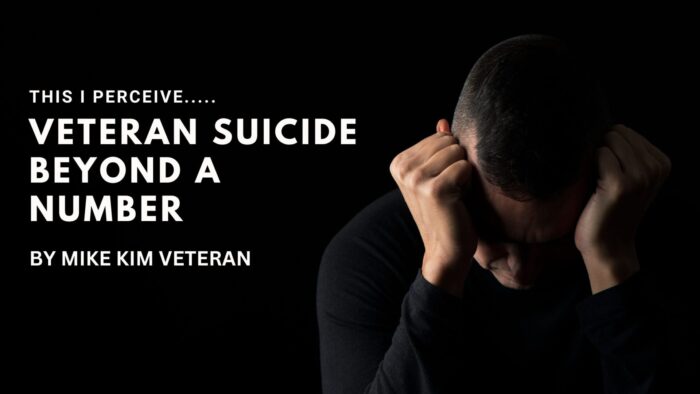This I Perceive… Veteran Suicide Beyond a Number
By Mike Kim Veteran
Essay #4 Veteran Readjustment Phenomena Series
I could go into the research tied to Veteran suicide. I won’t! Mass media has created a spectacle bordering an indirect mockery by just mentioning “Veteran Suicide” and then a number as the code to engage the pressing dilemma a number of Veterans and active-duty military personnel face in their real lives. The real lives do not seem to be fully captured in mass media descriptions of Veteran suicide in many books, films, plays, research studies, etc. Instead, society is left with limited explanations for understanding and interpreting this particular Veteran phenomenon. The Veteran suicide “number” mentioned by mass media and others does not tell a more comprehensive story about Veteran suicide. Is it a lie? No, but I will share some of my explorations regarding the phenomenon of Veteran suicide, going beyond statistical information of the official lethal means involved in suicide deaths “firearms, poisoning suffocation, and other” from the 2022 U.S. Department of Veteran Affairs National Vet Suicide Prevention Annual Report.
Suicide among military personnel has been played out in many performances, creative fictional/non-creative narratives especially in popular culture during this Post 9/11 Global War on Terrorism with several plays, movies, poems, books, documentaries, etc. like Jarhead, Man Down, PBS’ Still Taking Casualties, Theater of War Project, etc. The documentary short film Crisis Hotline: Veterans Press 1 even won an Academy Award in 2015. While these performances and creative narratives are valuable for understanding Veteran suicide, I am still left desiring more details about the often misunderstood and unseen tragedy in the lives of a number American warriors.
The Theater of War Project shown on college campuses, Veterans hospitals, and military installations across America has touched many lives. Ironically, the Project performance I experienced was Sophocles’ Ajax, based on the great mythological Greek military leader Ajax, left me mostly numb. As I checked out the Project during the height of our most recent 20 yearlong war, I wondered why I was negatively triggered by it after my long subway ride home, after the performance. And yet, I value the Project and other expressions of art tied to Veterans. I just cannot help but to voice what is lacking in many of these artistic pieces depicting Veteran suicide. Maybe, it is because of my dark thoughts throughout my Veteran journey. And also, how Veteran suicide only becomes an issue with society when there is a war featured in mass media. I have been dealing with Veteran suicide with Veterans for decades.
After some time, I could not help but to think about real people in my life who had taken their lives in and out of uniform. The narratives I experienced were real. The Project did not inspire me to think of these people but to instead be tied to Sophocles’ understanding of ancient mythological military-veteran suicide without reflecting on military suicides and real military leaders tied to suicide in my present reality, at that time, as a War trauma readjustment therapist with over 20000 clinical hours treating veterans and active-duty military personnel who were in the mountains of Afghanistan, deserts of the Middle East, jungles of Vietnam, Europe and Asia during WW II, and the horrific three-year War in Korea.
The great ancient war strategist Hannibal, Julius Caesar’s killer Roman General Marcus Brutus, reputed American Civil War General Johnson of the Union Army, Colonel Charles Piroth, the lead artillery officer in the French Army at the Battle of Dien Bien Phu, and other well-known military leaders throughout military history have something in common in that they all committed suicide. These were brilliant military men and they ended their lives due to visible and invisible wounds of military service. These great military men struggled with suicide and their suicide narratives are hidden from the masses.
I mention these names because traditionally the dynamic of suicide in Western military- veteran dialogues has traditionally been tied to mental weakness. Usually, the obscure and odd low military ranking warrior has been tied to many discussions about military- veteran suicide. In reality, suicide has been a major inner dynamic for military personnel of all backgrounds. Mentioning real human beings helps me want to know more about Veteran suicide.
I have been working with Veterans since the early 1990’s and Veteran suicide has been a problem that is not so easily understood by a mere number or by an arts performance, or by formal big research studies. We need to explore the lives of those warriors who have survived suicide in new revelations and expressions of Veteran narratives. I survived Veteran suicide back in 2016, as I pursued a whistleblower against the VA and that particular reality mirrored facing the enemy while I was wearing a uniform. And, that experience with Veteran suicide is quite different from what I have experienced checking out a NY Times Bestseller, or from Netflix, or from Broadway. Much of Veteran suicide in our society is either unseen or treated as fiction. Not much has emerged about gathering the fragments of life after Veteran suicide. I spoke to a friend a few days ago just before Christmas about real alternatives that would help him as he mentioned suicide. He is a great Marine in a dark place. I stayed with him for hours and fed him at a great restaurant and gave him real options tied to certain harsh economic struggles he is presently experiencing. We agreed that he had other options and we left each other with a joke and a smile. There are no guarantees in life. But, I know that I left him, in my heart, not preoccupied with certain limited perceptions about his reality. I know that he feels the care I have for him. I leave him this and I also open myself to him if he is in need to discuss more about his challenge. He is aware of the Veteran Crisis Line at the VA, but there is also more available to him.


